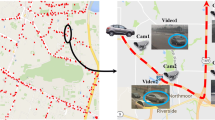Abstract
Sprite coding, as standardized in MPEG-4 Visual, can result in superior performance compared to common hybrid video codecs. We consider sprite coding, which significantly increases the objective as well as the subjective quality of coded video content. The main challenge of this approach is the segmentation of the foreground objects in a preprocessing step. We evaluate automatic object segmentation methods based on global motion estimation and background sprite generation. The objects are coded using the MPEG-4 Visual Main Profile and compared with the Advanced Simple Profile.


















Similar content being viewed by others
References
Antonini M, Barlaud M, Mathieu P, Daubechies I (1992) Image coding using wavelet transform. IEEE Trans Image Process 1(2):205–220
Baker S, Matthews I (2001) Equivalence and efficiency of image alignment algorithms. In: Computer vision and pattern recognition, 2001. CVPR 2001. Proceedings of the 2001 IEEE computer society conference, vol 1, pp I-1090–I-1097
Baker S, Matthews I (2004) Lucas-Kanade 20 years on: a unifying framework. Int J Comput Vis 56(3):221–255
Calderbank AR, Daubechies I, Sweldens W, Yeo B-L (1997) Lossless image compression using integer to integer wavelet transforms. In: Image processing, 1997. Proceedings, international conference on Oct 1997, vol 1, pp 596–599
Daubechies I (1992) Ten lectures on wavelets. Society for Industrial Mathematics, Philadelphia
Dufaux F, Konrad J (2000) Efficient, robust, and fast global motion estimation for video coding. IEEE Trans Image Process 9(3):497–501
Farin D (2005) Automatic video segmentation employing object/camera modeling techniques. Ph.D. thesis, Eindhoven University of Technology
Farin D, de With PHN, Effelsberg W (2004) Minimizing MPEG-4 sprite coding-cost using multi-sprites. In: SPIE visual communications and image processing
Farin D, de With PHN, Effelsberg WA (2004) Video-object segmentation using multi-sprite background subtraction. In: Multimedia and expo, 2004. ICME ’04. 2004 IEEE international conference, Jun 2004, vol 1, pp 343–346
Farin D, Haller M, Krutz A, Sikora T (2008) Recent developments in panoramic image generation and sprite coding. In: Proc. IEEE 10th workshop on multimedia signal processing, Oct 2008, pp 64–69
Fischler MA, Bolles RC (1981) Random sample consensus: a paradigm for model fitting with applications to image analysis and automated cartography. Commun ACM 24(6):381–395
Haller M, Krutz A, Sikora T (2009) Evaluation of pixel- and motion vector-based global motion estimation for camera motion characterization. In: Proceedings of the international workshop on image analysis for multimedia interactive services (WIAMIS 2009). London, UK, ISBN 978-1-4244-3610-1, pp 49–52
Krutz A, Frater M, Kunter M, Sikora T (2006) Windowed image registration for robust mosaicing of scenes with large background occlusions. In: Proc. IEEE international conference on image processing, Oct 2006, pp 353–356
Krutz A, Glantz A, Frater M, Sikora T (2008) Local background sprite generation. In: International workshop on local and non-local approximation in image processing, LNLA 2008. IEEE, EURASIP, Tampere International Center for Signal Processing (TICSP), EUSIPCO2008, IEEE, EURASIP, Lausanne, Switzerland, Aug 2008
Krutz A, Glantz A, Sikora T, Nunes P, Pereira F (2008) Automatic object segmentation algorithms for sprite coding using MPEG-4. In: Grgic S, Grgic M (ed) 50th international symposium ELMAR-2008, September, Proceedings, Zadar, Croatia, vol 2 of 2. Department of Wireless Communications, Faculty of Electrical Engineering and Computering, University of Zagreb, Croatia, ELMAR, Zadar, ELMAR, Croatian Society Electronics in Marine, Zadar, pp 459–462
Krutz A, Glantz A, Borgmann T, Frater M, Sikora T (2009) Motion-based object segmentation using local background sprites. In: Proceedings of the IEEE international conference on acoustics, speech and signal processing (ICASSP 2009), Taipei, Taiwan, Apr 2009
Krutz A, Kunter M, Dröse M, Frater M, Sikora T (2007) Content-adaptive video coding combining object-based coding and H.264/AVC. In: Picture coding symposium, Lisbon, Portugal, Nov 2007
Krutz A, Kunter M, Sikora T, Mandal M, Frater M (2007) Motion-based object segmentation using sprites and anisotropic diffusion. In: Proc. eighth international workshop on image analysis for multimedia interactive services WIAMIS ’07, Jun 2007, pp 35–35
Kunter M (2008) Advances in sprite-based video coding—towards universal usability. Ph.D. thesis, Technische Universität Berlin
Kunter M, Krutz A, Mandal M, Sikora T (2007) Optimal multiple sprite generation based on physical camera parameter estimation. In: Visual communications and image processing, VCIP, electronic imaging 2007, San José, CA, USA, Jan 2007
Kunter M, Krutz A, Dröse M, Frater M, Sikora T (2007) Object-based multiple sprite soding of unsegmented videos using H.264/AVC. In: IEEE int. conf. on image processing (ICIP 2007), San Antonio, Texas, USA, Sep 2007
Lucas BD, Kanade T (1981) An iterative image registration technique with an application to stereo vision. In: International joint conference on artificial intelligence, Aug 1981, pp 674–679
Mech R, Wollborn M (1997) A noise robust method for segmentation of moving objects in video sequences. In: Proc. IEEE international conference on acoustics, speech, and signal processing ICASSP-97, vol 4, pp 2657–2660
Pereira F, Ebrahimi T (2002) The MPEG-4 book. Prentice Hall, Upper Saddle River
Perona P, Malik J (1990) Scale-space and edge detection using anisotropic diffusion. IEEE Trans Pattern Anal Mach Intell 12(7):629–639
Sikora T (1997) The MPEG-4 video standard verification model. IEEE Trans Circuits Syst Video Technol 7(1):19–31
Sikora T (2005) Trends and perspectives in image and video coding. In: Proc. of the IEEE, vol 93, pp 6–17
Shi J, Tomasi C (1994) Good features to track. In: Proc. CVPR ’94. IEEE computer society conference on computer vision and pattern recognition, Jun 1994, pp 593–600
Smolic A, Sikora T, Ohm J-R (1999) Long-term global motion estimation and its application for sprite coding, content description, and segmentation. IEEE Trans Circuits Syst Video Technol 9(8):1227–1242
Tomasi C, Kanade T (1991) Detection and tracking of point features. Tech. Rep., Technical Report CMU-CS-91-132, Carnegie Mellon University, Apr 1991
Wiegand T, Sullivan GJ, Bjontegaard G, Luthra A (2003) Overview of the H.264/AVC video coding standard. IEEE Trans Circuits Syst Video Technol 13(7):560–576
Author information
Authors and Affiliations
Corresponding author
Rights and permissions
About this article
Cite this article
Glantz, A., Krutz, A., Sikora, T. et al. Automatic MPEG-4 sprite coding—Comparison of integrated object segmentation algorithms. Multimed Tools Appl 49, 483–512 (2010). https://doi.org/10.1007/s11042-010-0469-3
Published:
Issue Date:
DOI: https://doi.org/10.1007/s11042-010-0469-3




